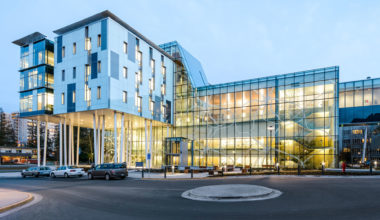In Grade 10, fifteen- and sixteen-year-olds begin making the academic decisions that may shape their lives, opting for electives in the sciences or the arts. What they choose will influence where they plan to go to university, what they plan to study, and who they ultimately become.
For many scientists, their earliest interest in science is sparked by someone else. Before they can even conceive of a career in research or medicine, they have to understand that it is possible. Igniting a young person’s passion for science or medicine is often as simple as someone showing them that opportunity is out there. For a group of students from a Vancouver high school, researchers, clinicians and students with the UBC MS & NMO Program took it upon themselves to be the spark.
On January 22, 140 Grade 10 students from Price of Wales Secondary School visited the Djavad Mowafaghian Centre for Brain Health.
“For many of the students who attended, this was their first chance to interact with researchers,” said Dr. Tony Traboulsee, whose team organized the event. “It was their first opportunity to sit in a lecture theatre and hear about the individual path each researcher, clinician or student followed to get to where they are.”
The students were given rare insight into individual researchers’ career paths, from the challenges along the way and the value of failure, to reassurance that it’s okay to change course, and the importance of finding an area of science or medicine that piques their curiosity and challenges them.
“I would have loved to have had an occasion like this when I was their age,” said Dr. Brian MacVicar, who provided opening remarks. “This was a great chance to show young people what really goes on in a research lab, and to inspire them to follow a path that offers a lot more in terms of their options than they might expect. It took me until university to figure that out – the MS & NMO Program has given these kids a head-start.”
“While many of the students started out the day showing lukewarm enthusiasm about science, it was wonderful to see the excitement grow as they saw more about what a day in the life of a scientist was like,” said Dr. Shannon Kolind. “There were so many great questions and everyone was very engaged. It was highly rewarding.”
According to Michelle Eisner, Program Coordinator for the UBC MS Connect Education Program, the flagship event was meant to influence students on the cusp of choosing their courses for their senior years in high school.
“If they’re not sure whether they want to pursue science or physical education or the arts, we wanted to give them a peek at what a career in science might have to offer them,” Eisner said. “If they had doubts that science was for them, we wanted to dispel those notions and reveal the diversity of choices available to them.”
“Introducing high school students to positive, enthusiastic research role models will help them prepare for university,” said Dr. Traboulsee. “What really inspired many of the students was not only the passion DMCBH neuroscience researchers have, but also the large number of women who are having successful and rewarding careers. This event really opens the eyes of many students who may never have considered a career in science.”


